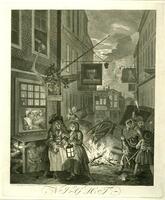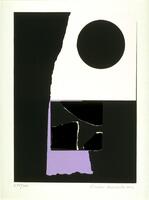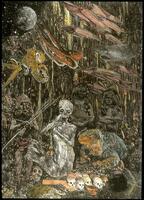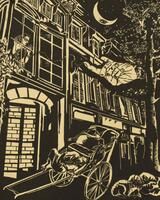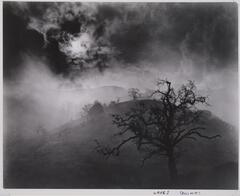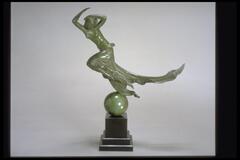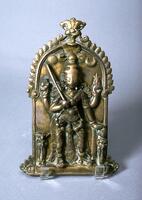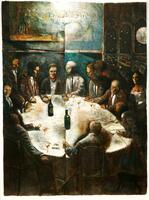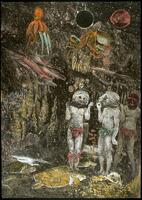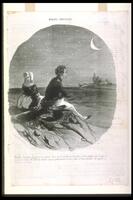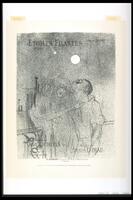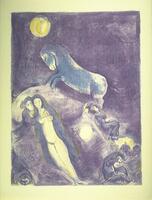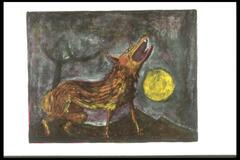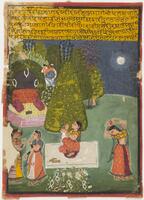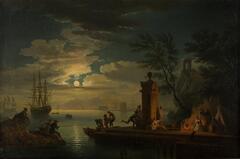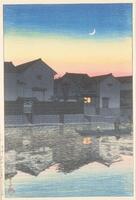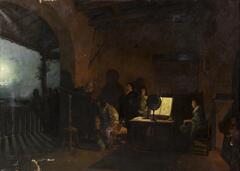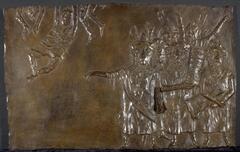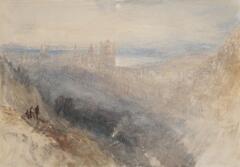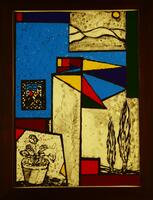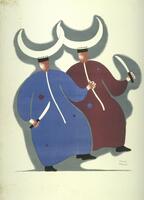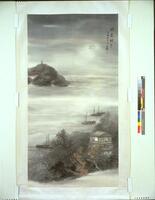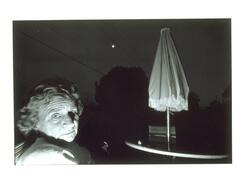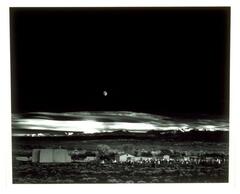The Moon has been looming overtop of humans since before recorded history. The silent counterpart to the mighty sun, the moon is ever present in our eyes, our minds, and in our imagination. The way the moon has been weaved into different mythologies, religions, traditions, and cultures from all around the world is astounding but also not surprising, as the moon is something we all experience. This introspective look at artworks featuring the Moon strives to make comparisons between works that span centuries and many different style and mediums, all of whom share the same goal of depicting something we see every night, the Moon.
33 Items in this Learning Collection
Collection Object
Collection Object
Collection Object
Collection Object
Collection Object
Collection Object
Collection Object
Collection Object
Collection Object
Collection Object
Collection Object
Collection Object
Collection Object
Collection Object
Collection Object
Collection Object
Collection Object
Collection Object
Collection Object
Collection Object
Collection Object
Collection Object
Collection Object
Collection Object
Collection Object
Collection Object
Collection Object
Collection Object
Copyright
All Rights Reserved
()
Autumn Moon at Mt. Dongting
Accession Number
1998/2.7
Title
Autumn Moon at Mt. Dongting
Artist(s)
Wu Qingyun (Wu Ch'ing-yun)
Object Creation Date
1903
Medium & Support
hanging scroll, ink and light color on paper
Dimensions
6 ft. 1 1/16 in. x 38 7/16 in. (185.5 x 97.5 cm);3 in. x 4 ft. 4 3/8 in. x 2 9/16 in. (7.5 x 133 x 6.4 cm)
Credit Line
Gift of John Schloss
Label copy
Inscription: Autumn Moon at Mount Dongting. Summer, 1903. Shixian
Seal of the artist
A Shanghai artist of the early twentieth century, Wu Qingyun uses dark, wet ink wash and light accents of color to capture the lyrical mood of an autumnal moonlit night at Lake Tai and Mount Dongting. Having traveled to Japan, Wu appears to have been aware of both Japanese art and European Impressionism, expanding his artistic vision. Up close the boats appear as freely brushed lines and yet at a distance, their forms come into focus. This subtle use of loose brushwork suggests impressionism, marking the beginning of a new phase in the development of Chinese painting.
----
A Shanghai artist of the early twentieth century, Wu Qingyun uses dark, wet ink wash and light accents of color to capture the lyrical mood of an autumnal moonlit night at Lake Tai and Mount Dongting. Having traveled to Japan, Wu appears to have been aware of both Japanese-and European-style painting, drawing upon these to expand his artistic vision. Up close the boats appear as freely brushed lines, and yet at a distance, their forms come into focus. This subtle use of loose brushwork suggests Impressionism, marking the beginning of a new phase in the development of Chinese painting.
(Chinese Gallery Rotation, Fall 2010)
Gallery Rotation Fall 2010
Wu Qingyun
China, 1845–1916
Autumn Moon at Mt. Dongting
Qing Period (1644–1912)
1903
Hanging scroll, ink, and light color on paper
Gift of John Schloss, 1998/2.7
A Shanghai artist of the early twentieth century, Wu Qingyun uses dark, wet ink wash and light accents of color to capture the lyrical mood of an autumnal moonlit night at Lake Tai and Mount Dongting. Having traveled to Japan, Wu appears to have been aware of both Japanese-and European-style painting, drawing upon these to expand his artistic vision. Up close the boats appear as freely brushed lines, and yet at a distance, their forms come into focus. This subtle use of loose brushwork suggests Impressionism, marking the beginning of a new phase in the development of Chinese painting.
Subject matter
A Shanghai artist of the early twentieth century. Having traveled to Japan, Wu appears to have been aware of both Japanese-and European-style painting, drawing upon these to expand his artistic vision. Subtle use of loose brushwork suggests Impressionism, marking the beginning of a new phase in the development of Chinese painting.
Physical Description
Dark, wet ink wash and light accents of color capture the lyrical mood of an autumnal moonlit night at Lake Tai and Mount Dongting. A round moon hangs low in the sky at top right, with a diffuse glow slightly brightening the clouds and sky below. Two islands sit in the water below, the larger (closer) of the two has four boats moored just offshore. Up close the boats appear as freely brushed lines, and yet at a distance, their forms come into focus. A building sits on the closer island, light shining in the windows. The silhouette of a pagoda can be seen on the further island.
Primary Object Classification
Painting
Primary Object Type
hanging scroll
Additional Object Classification(s)
Painting
Collection Area
Asian
Rights
If you are interested in using an image for a publication, please visit http://umma.umich.edu/request-image for more information and to fill out the online Image Rights and Reproductions Request Form.
Keywords
Landscapes
autumn
boats
houses
landscapes (environments)
moons
trees
water
water (inorganic material)
1998/2.7
Title
Autumn Moon at Mt. Dongting
Artist(s)
Wu Qingyun (Wu Ch'ing-yun)
Object Creation Date
1903
Medium & Support
hanging scroll, ink and light color on paper
Dimensions
6 ft. 1 1/16 in. x 38 7/16 in. (185.5 x 97.5 cm);3 in. x 4 ft. 4 3/8 in. x 2 9/16 in. (7.5 x 133 x 6.4 cm)
Credit Line
Gift of John Schloss
Label copy
Inscription: Autumn Moon at Mount Dongting. Summer, 1903. Shixian
Seal of the artist
A Shanghai artist of the early twentieth century, Wu Qingyun uses dark, wet ink wash and light accents of color to capture the lyrical mood of an autumnal moonlit night at Lake Tai and Mount Dongting. Having traveled to Japan, Wu appears to have been aware of both Japanese art and European Impressionism, expanding his artistic vision. Up close the boats appear as freely brushed lines and yet at a distance, their forms come into focus. This subtle use of loose brushwork suggests impressionism, marking the beginning of a new phase in the development of Chinese painting.
----
A Shanghai artist of the early twentieth century, Wu Qingyun uses dark, wet ink wash and light accents of color to capture the lyrical mood of an autumnal moonlit night at Lake Tai and Mount Dongting. Having traveled to Japan, Wu appears to have been aware of both Japanese-and European-style painting, drawing upon these to expand his artistic vision. Up close the boats appear as freely brushed lines, and yet at a distance, their forms come into focus. This subtle use of loose brushwork suggests Impressionism, marking the beginning of a new phase in the development of Chinese painting.
(Chinese Gallery Rotation, Fall 2010)
Gallery Rotation Fall 2010
Wu Qingyun
China, 1845–1916
Autumn Moon at Mt. Dongting
Qing Period (1644–1912)
1903
Hanging scroll, ink, and light color on paper
Gift of John Schloss, 1998/2.7
A Shanghai artist of the early twentieth century, Wu Qingyun uses dark, wet ink wash and light accents of color to capture the lyrical mood of an autumnal moonlit night at Lake Tai and Mount Dongting. Having traveled to Japan, Wu appears to have been aware of both Japanese-and European-style painting, drawing upon these to expand his artistic vision. Up close the boats appear as freely brushed lines, and yet at a distance, their forms come into focus. This subtle use of loose brushwork suggests Impressionism, marking the beginning of a new phase in the development of Chinese painting.
Subject matter
A Shanghai artist of the early twentieth century. Having traveled to Japan, Wu appears to have been aware of both Japanese-and European-style painting, drawing upon these to expand his artistic vision. Subtle use of loose brushwork suggests Impressionism, marking the beginning of a new phase in the development of Chinese painting.
Physical Description
Dark, wet ink wash and light accents of color capture the lyrical mood of an autumnal moonlit night at Lake Tai and Mount Dongting. A round moon hangs low in the sky at top right, with a diffuse glow slightly brightening the clouds and sky below. Two islands sit in the water below, the larger (closer) of the two has four boats moored just offshore. Up close the boats appear as freely brushed lines, and yet at a distance, their forms come into focus. A building sits on the closer island, light shining in the windows. The silhouette of a pagoda can be seen on the further island.
Primary Object Classification
Painting
Primary Object Type
hanging scroll
Additional Object Classification(s)
Painting
Collection Area
Asian
Rights
If you are interested in using an image for a publication, please visit http://umma.umich.edu/request-image for more information and to fill out the online Image Rights and Reproductions Request Form.
Keywords
Landscapes
autumn
boats
houses
landscapes (environments)
moons
trees
water
water (inorganic material)
